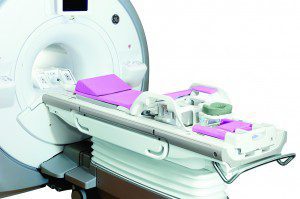By Ryan Polselli, M.D., Breast Imaging Radiologist
 Breast MRI is a specialized form of MRI specifically designed to detect breast cancer. Although there is no radiation and it does not require the firm type of compression as with mammography, it does require intravenous contrast and you must lie on your stomach in an MRI scanner for approximately 20 minutes.
Breast MRI is a specialized form of MRI specifically designed to detect breast cancer. Although there is no radiation and it does not require the firm type of compression as with mammography, it does require intravenous contrast and you must lie on your stomach in an MRI scanner for approximately 20 minutes.
Breast MRI can detect cancer that may not necessarily be seen with mammography, particularly if you have dense breast tissue. In general, the denser the breast tissue, the more difficult it is to detect cancer with mammogrpahy. Studies have repeatedly proven that women with dense breast tissue may benefit from adding breast MRI into their breast cancer screening routine, a fact of which many patients are unaware.
As a result, approximately half of all states have enacted legislation (Florida has introduced a bill) requiring notification of this fact to patients with dense breast tissue. Some states now require insurance companies to manditorily cover the cost of breast cancer screening with breast MRI. All mammograms currenty classify the density of breast tissue and if your report uses the words “heterogenously dense” or “extremely dense” you may want to discuss the value of breast MRI with your doctor.
Studies have also proven that annual screening with breast MRI can aid in the early detection of breast cancer in patients that have a high lifetime risk for developing breast cancer. The American Cancer Society now recommends yearly breast MRI, in addition to annual screening mammography, for anyone that is considered to have greater than 20% lifetime risk for developing breast cancer.
While there are many factors that may put you at high risk of developing breast cancer, some of the most important factors to consider are whether there is a history of any first degree relatives in your family that have had breast cancer, a personal history of breast cancer or abnormal cells from biopsies, if you are a carrier of certain genes linked to breast cancer, if you have never had children or if your first child was after the age of 30, radiation therapy to the chest, estrogen exposure and hormone replacement therapy, and your ethnic background (caucasian women are at slightly higher risk than other ethnicities).
If you think you may have a high risk, one of the most useful tools available to accurately quantify your risk is the Tyrer-Cuzick risk assessment tool which is available online at http://www.ems-trials.org/riskevaluator/. If after completing the survey you have greater than a 20% lifetime risk, you should consider adding annual breast MRI to your breast cancer screening routine. Most of the time, this is done by alternating annual breast MRI with annual mammogram at 6 month intervals.
Although breast MRI is extremely sensitive and useful in detecting breast cancer, it can often be more difficult to interpret than mammogram or ultrasound and sometimes differentiating cancer from benign tissue can pose diagnostic challenges that may require biopsy or additional follow-up studies. This can be minimized by ensuring your study is read by either a fellowship trained breast imaging radiologist or a radiologist with sepcial training and expertise in breast MRI.
For more information about breast MRI, call Advanced Imaging at 941-235-4646 today.









